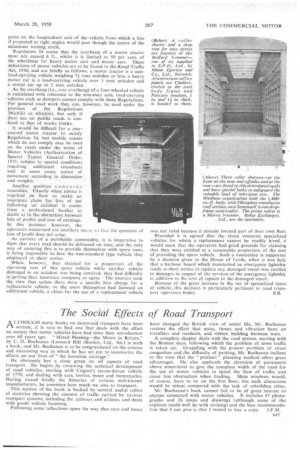The Social Effects of Road Transport
Page 79

If you've noticed an error in this article please click here to report it so we can fix it.
A',THOUGH many books on motorized transport have been written, it is rare to find one that deals with the effect on society that motor vehicles have had since their introduction over 60 years ago. "Mixed Blessing—the Motor in Britain," by C. D. Buchanan (Leonard Hill (Books), Ltd., 30s.) is such a book, and Mr. Buchanan is to he congratulated on the concise and interesting way in .which he has set out to summarize the effects on our lives of " the horseless carriage."
He obviously has a close grasp on all aspects of road transport. He begins by reviewing the technical development of road vehicles, starting with Cugnot's steam-driven vehicle of 1770, and dealing with cars, lorries, buses and motorcycles. Having traced briefly the histories of various well-known manufacturers, he considers how much we owe to transport.
This seCtion of the book is backed by several useful tables of statistics showing the amount of traffic carried by various transport systems, including the railways and airlines, and deals with goods vehicle licensing.
Following some reflections upon the way that cars and buses have changed the British view of social life, Mr. Buchanan reviews the effect that noise, fumes and vibration have on travellers and residents, and ribbon building between wars.
A complete chapter deals with the road system, starting with the' Roman days, following which the problem of town traffic is taken up, Grappling with the present problem of street congestion and the difficulty of parking, Mr. Buchanan inclines to the view that the " precinct " planning method offers great advantages. He also applauds the elevation of pavements above street-level to give the complete width of the road for the use of motor vehicles to speed the flow of traffic and cause less obstruction when loading. Shop windows would, of course, have to be on the first floor, but such alterations would be minor compared with the task of rebuilding cities.
Mr. Buchanan's book cannot fail to be of great interest to anyone connected with motor vehicles. It includes 47 photographs and 26 maps and drawings (although some of the captions could well do with revising) and the best recommenda
tion that I can give is that I intend to buy a copy. .L.F.M.




















































































































